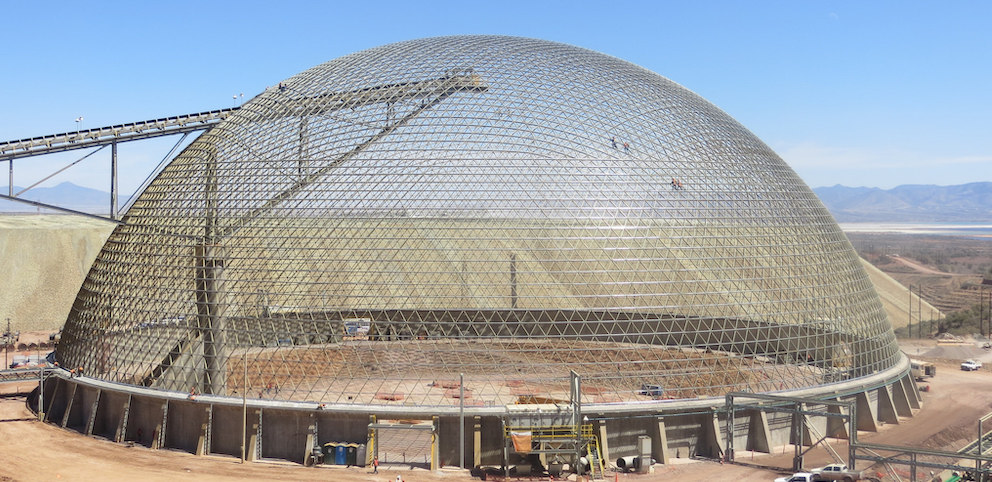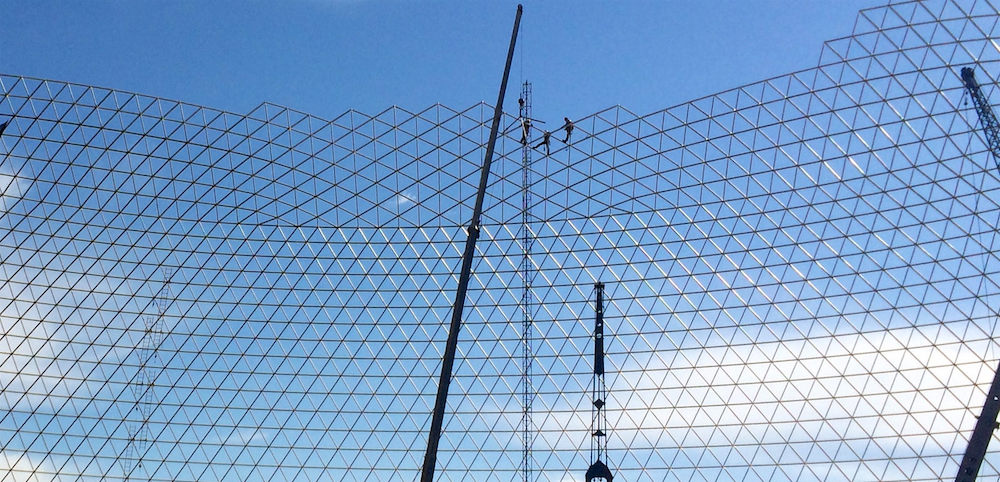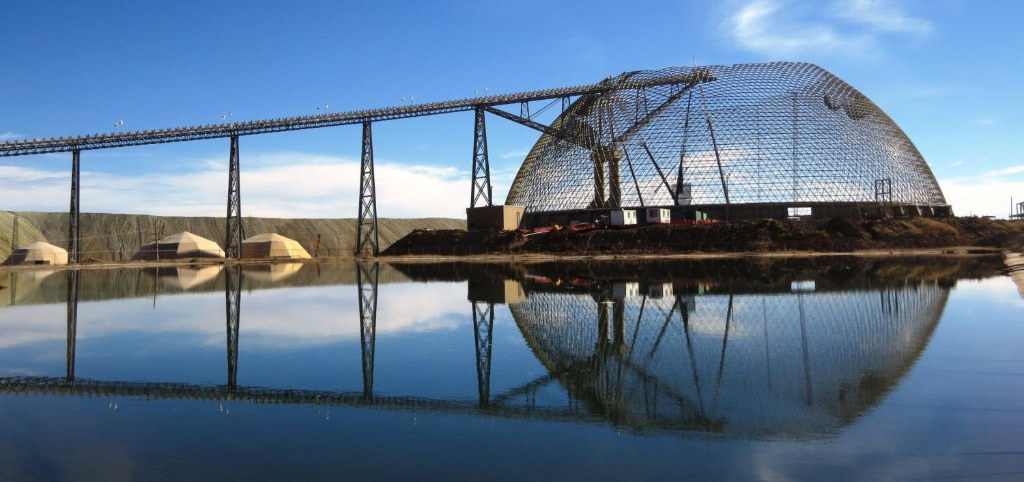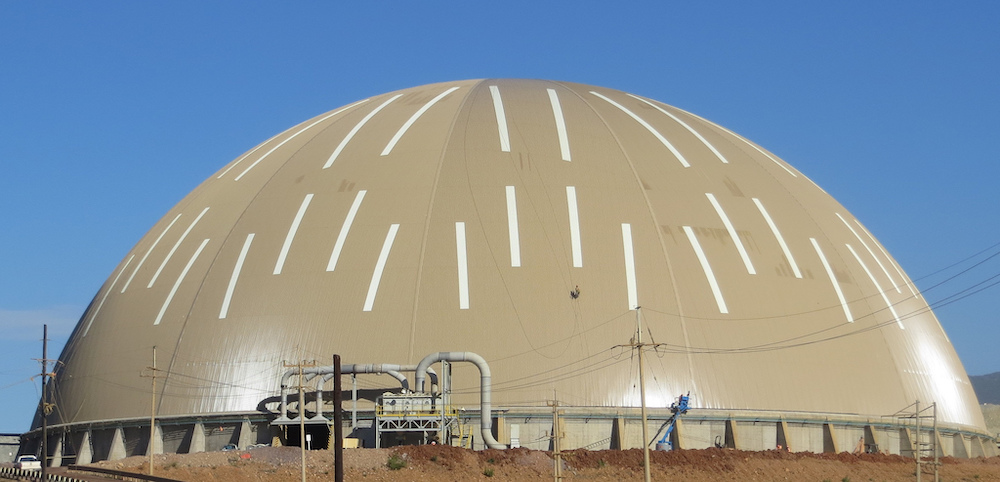Strength through curvature and slenderness
From those words, you'd think this article is about yoga. Sorry, no. It is about domes, again. Engineers find these words exciting even when not applied to such fun pursuits.
In engineering, slenderness may mean the span of a structure divided by its thickness. Domes are very slender because they span large distances while being very thin. The curvature in a dome provides strength through geometry rather than material. This translates into efficient structures that cost less. Modern, responsible companies that handle bulk materials use slender domes to cover their stockpiles and protect the environment. One such company is the Buenavista mine in Northern Mexico.
Dome section view
Construction started at the perimeter support wall
Spiders are pre-assembled on the ground...
In the late 1990s Buenavista first installed an 88m Geometrica dome to cover their crushed material stockpile, preventing dust from escaping into the environment. 15 years later, growing operations required a new stockpile and, therefore, a new dome. At 125m diameter, the new dome would enclose a volume nearly 3 times larger than the earlier dome. Complicating construction, the dome would have to be built on a 6m high concrete wall, and around a stacking conveyor scheduled to be built before the dome.
The design called for using a single-layer framework for the dome. Having a single layer of tubes, rather than two layers, reduces the time to manufacture and install the building, while making the structure extremely slender. But there can be too much of a good thing. Too much slenderness can increase the tendency of a structure to lose its balance, or "stability". To picture the slenderness challenge for this dome, we can compare with shells in nature. Eggshells are one well known example in nature of strength through geometry. A typical Easter egg's diameter is, say, 50mm, and its thickness is, say, 1/3 of a millimeter. Then such eggshell's slenderness is 50 divided by 0.333, or 150. With a diameter of 125,000mm and thickness of, say, 150mm, this dome's slenderness is 833. Therefore, proportionately, this dome would be five and a half times more slender than an eggshell. To resist the specified wind and roof loads, Geometrica had to design a very strong and stable structure despite its unbelievable slenderness.
As a first trial, Geometrica engineers explored the use of circular tubes for the dome's framework. Circular tubes are very efficient as individual elements because they spread the material away from the axis of the bar, increasing those individual elements' stability. The dome would require steel tubes that were, indeed, 150mm in diameter in order to achieve the desired strength and stability. But the circular tubes were not ideal. In a single-layer dome, "general buckling", as opposed to "individual element buckling" is more critical. This means that a "dimple" in this dome produced by buckling would be much longer than an individual bar. It is because of this general buckling that the diameter of the tubes had to be 150mm, even though for individual bar buckling, the tubes only needed about a third of that. Circular tubes made the structure heavier than necessary. So the thinking yoga-pose was struck again.
...and hoisted to the workfront
Geometrica engineers then considered rectangular tubes. These would be an improvement, as the shape could be oriented to provide more stiffness in the direction needed, without adding too much material in the other direction. Unfortunately, rectangular tubes of the desired dimensions have a disadvantage: they are not "compact". This means that the walls that conform the tube, not having curvature themselves, tend to buckle "locally", weakening the tube. Deep meditation yielded another idea: What about using an oval section? Such profile would provide the advantage of increased stiffness against general buckling, like the rectangular section, and the curved sides should make the tube "compact". Geometrica's tubing supplier agreed such oval could indeed be made. All that remained to proceed with this profile was to make sure that it was indeed compact, as the hunch was not sufficient.
There is little guidance in published codes and standards about the behavior of oval sections. Geometrica approached Professor Cris Moen and Research Assistant Aritra Chaterjee at the department of Civil and Environmental Engineering in Virginia Tech, to help verify the adequacy of the assumption. Dr. Moen and Mr. Chatterjee modeled the section in the CUFSM software using the finite strip method, and tested a few sample sections to failure. The results were successful, confirming that the section was indeed compact. The results of the study were presented at the ASCE 2014 Structures Congress in Boston, MA.
Single layer framework almost complete
The dome went on to be manufactured and built as shown in the pictures here. Construction started at the perimeter and proceeded upwards ring by ring. The growing, partially-completed dome was always self-supporting and sufficiently strong for the construction loads. Both in the dome and in the oval tubes that make it up, curvature and slenderness deliver great strength.
Finished dome framework
You, too, can use a Geometrica Freedome® for your next storage project and relax in the knowledge that the environment is being saved.
So strike your favorite pose, breathe the pure air, and visualize the curves, the slenderness and the strength.
While domes may never be hotter than yoga pants, they may yet help you reach environmental Nirvana.
Please fill our inquiry form so Geometrica can give you the cover your project deserves.












